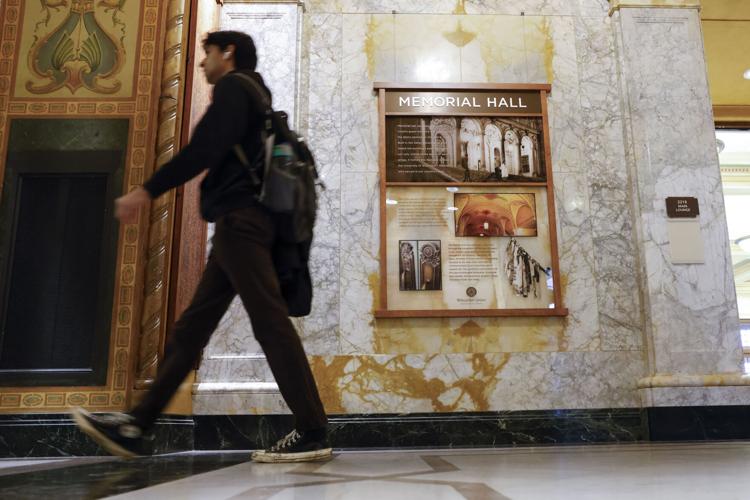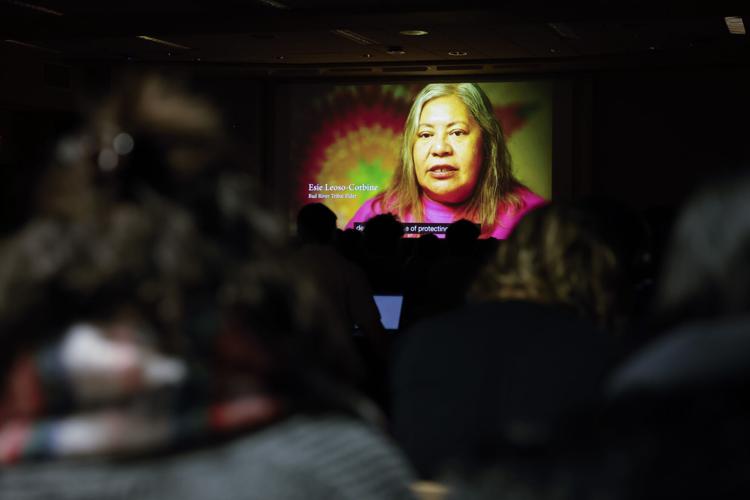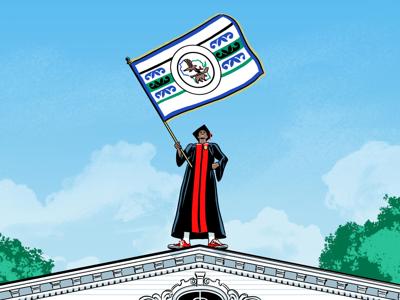Paige Blackdeer and Juno O’Connor yearn to see more Native students at the University of Wisconsin-Madison.
Growing up in Black River Falls, Blackdeer tutored classmates in high school, including fellow members of the Ho-Chunk Nation. Many of the students she helped were “so smart and definitely could go to a school like Madison,” she said — if only they were given the opportunity.
O’Connor arrived at UW-Madison this year hoping to connect with Native people other than family members. Maybe six or seven Native students attended O’Connor’s high school in Sun Prairie.
“Me and my sisters were three of them,” said O’Connor, an enrolled member of the Red Cliff Band of Lake Superior Chippewa.
As a first-year student, O’Connor chose to live in a designated Indigenous community in Smith Residence Hall. The community provides academic support and cultural events on a campus where Native American students make up roughly 1% of total enrollment.
This fall, Blackdeer and O’Connor are among 73 undergraduate students selected as inaugural recipients of a new UW-Madison financial aid program created to help Native students attend the university.
The privately funded program, known as the Wisconsin Tribal Educational Promise, covers the full cost of attendance for in-state students who are enrolled members of one of the 11 federally recognized tribes in Wisconsin.
Blackdeer and O’Connor said UW-Madison’s new program is a good first step to help other Native students afford the university.
“I think it’s a nice way to sort of get reparations for Native people,” O’Connor said.
Like other land-grant universities, UW-Madison has troubled, devastating origins. The university was built on the Ho-Chunk Nation’s ancestral homeland, known as Teejop. People lived in the area for thousands of years before the U.S. government seized the land to help establish UW-Madison.
Colleges across the country continue to benefit, financially and in other ways, from land that was taken from tribes, often through force and violence.
“Meanwhile, Indigenous people remain largely absent from student populations, staff, faculty and even curriculum,” according to “Land-grab universities,” a 2020 investigation by High Country News.
At UW-Madison, no Native people from Wisconsin graduated from the university during its first 100 years, according to a project that explored the university’s history.
Blackdeer said it’s important for people on campus to recognize this history, while finding even more ways to better support Native students who attend the university in the years to come.
By offering financial aid programs, UW-Madison and other universities can help students and their families benefit from the institutions that uprooted Native Americans for generations.

Paige Blackdeer, who is an enrolled member of the Ho-Chunk Nation, watches the documentary “Bad River” while attending an American Indian Studies course, at the University of Wisconsin-Madison. Blackdeer, a junior, is participating in the Wisconsin Tribal Educational Promise Program this fall.
‘Fear of being displaced’
In high school, Blackdeer applied only to UW-Madison to attend college. With her parents’ encouragement, she developed a “really magical image of Madison” in her mind as a “hippy-dippy” place with lots to do and nice people.
Now, as a junior studying sociology with a certificate in American Indian Studies, Blackdeer said she remains happy about choosing UW-Madison even though she felt disillusioned when first arriving on campus.
“I have a more real understanding now,” she said.
Blackdeer learned that Bascom Hall was built on an effigy mound and that imagery used by past students to parody Native American life is still visible on Memorial Union doors.
Her first year on campus, students worried the university would tear down the house on North Brooks Street where the Indigenous Student Center is located. Nearby, the university is building a new College of Letters & Sciences building. UW-Madison says there are no current projects requiring the house to be removed, but future development on the block could include a parking structure.
That house provides a home for Native students to find a safe space to be together, said Serena Cisneros, a mental health provider on campus. The idea that it could be torn down for parking is disrespectful, she said.
“It’s ironic we’re always under this fear of being displaced,” said Cisneros, who is Anishinaabe from the Lac Courte Oreilles Reservation.
In 1862, President Abraham Lincoln signed the Morrill Act, which turned millions of acres of tribal land into funding for colleges across the country. In Wisconsin, over 1.3 million acres were taken through treaties with the Menominee, Ojibwe, Dakota and Ho-Chunk. The University of Wisconsin received 235,530 acres in the northern part of the state and sold the land for a profit of more than $300,000.
“Adjusted for inflation, this represents nearly $5 million that still benefits the university today,” according to UW-Madison’s “Sifting & Reckoning” project, which was created in recent years to delve into the university’s “history of exclusion and resistance.”
The U.S. government demanded the Ho-Chunk people, under duress, surrender the area where UW-Madison stands today through the Treaty of 1832.
“A U.S. army occupied large parts of Wisconsin, and the Ho-Chunk had no choice but to sell the land. … Decades of ethnic cleansing followed, during which the state and federal governments repeatedly sent soldiers to banish the Ho-Chunk from Teejop and the rest of their homeland,” the “Sifting & Reckoning” project says.
In spite of the treaties and violence, “many Ho-Chunk people refused to leave Wisconsin, and many others quickly returned.”

Juno O’Connor, a first-year student and enrolled member of the Red Cliff Band of Lake Superior Chippewa, attends attends a class at the University of Wisconsin - Madison. O’Connor says the Wisconsin Tribal Educational Promise Program is "a nice way to sort of get reparations for Native people."
Native enrollment
Part of what drew O’Connor to UW-Madison this fall was the ability to attend a great school while living close to family in Sun Prairie. O’Connor was enticed by the new financial aid program for Native American students.
“I was like, ‘Oh, that’s really freaking great!’ That’s just rolling out right as I’m applying for colleges,” O’Connor said.
In the last decade, the number of first-year applicants who identify as American Indian or Alaska Native has generally increased at UW-Madison. The university reported the highest number of applicants this year — 115 — since at least 2015. Still, the number admitted and enrolled decreased.
The university cautioned that its enrollment figures might underrepresent Native students, saying many identify as more than one race and could be counted in other demographic groups of students.
About a year ago, a UW-Madison spokesperson estimated about 650 students, including more than 460 undergraduates, identify as Native American. However, university officials said at the time they didn’t know how many in-state students are tribal members and would be eligible for the new financial aid program.
This fall, 22 first-year, nine transfer and 42 continuing students are participating in the Wisconsin Tribal Educational Promise Program, according to a campus spokesperson. Carla Vigue, director of tribal relations at UW-Madison, said she hopes those figures grow. But she’s cautious to not read too much into the numbers with this first group of 73.
“Any single person you help is super important. I grew up in a situation where I would have been one of the people that would have been helped by this program,” said Vigue, who is a member of the Oneida Nation.
Native Americans make up a small percentage of Wisconsin’s total population, Vigue said. More than 60,000 people, or about 1% of the state’s population, identify solely as American Indian or Alaska Native, according to the U.S. Census Bureau.
Vigue also recognized not every student will be interested in attending UW-Madison.
“As many as want to come, I want to be able to take care of them,” she said.

A 1920s depiction of Native Americans is still painted on the vaulted ceiling of UW-Madison's Memorial Union.
How the program began
Shortly after starting in her role at UW-Madison last year, Vigue said she met with Chancellor Jennifer Mnookin.
Mnookin had come to campus months earlier from the University of California, Los Angeles, which offered a tuition program for Native American students. Mnookin asked her to look into creating a similar program at UW-Madison, Vigue said.
Vigue began researching with other people on campus. She and Mnookin consulted with tribal nations around Wisconsin.
“After multiple discussions … it became clear to us that tuition waivers aren’t a new thing, and many states have them. But the tribes here let us know that they thought we could go further than that,” Vigue said.
Vigue heard concerns about family costs beyond tuition, such as food and housing.
“They wanted to make sure that if a student was to come here that they would be taken care of and … feel like they could still concentrate on classes and internships,” she said.
UW-Madison created a last-dollar program, meaning it guarantees scholarships and grants to cover participants’ remaining balance after financial aid is applied. The program covers room and board, books, fees and other expenses.
“I think there’s more we can do, and I think there’s more students we can reach. … But for now, this is what we’re going to start with, and this is where we’re going to start building from, and we’re pretty proud of it,” Vigue said.
UW-Madison could have defined eligibility for the program in different ways, she said. One reason the university decided to require students to be enrolled tribal members is because of a 2023 U.S. Supreme Court ruling against race-conscious admissions.
“Tribes and citizenship are different than ethnicity or race,” Vigue said.
The initiative is funded by private donations and other resources — not taxpayer money, according to UW-Madison. A campus spokesperson said the university won’t know the total cost until the end of the school year.
Universities of Wisconsin President Jay Rothman recently asked Gov. Tony Evers and state legislators for $5 million over the next two years to expand the financial aid program to the other 12 state universities in the UW system.
Jon Greendeer, president of Ho-Chunk Nation, said UW-Madison has been “extremely gracious” in doing the heavy lifting to establish the program. He’s “deeply appreciative” of Mnookin and her staff for making it happen.
The initiative helps remove one of the largest obstacles in pursuing higher education, he said, and the university benefits from recruiting and serving Native students.
Most of Wisconsin’s tribal communities are located in the northern half of the state, so some students might prefer to attend the UW system’s other four-year universities or two-year campuses, according to Greendeer. If UW-Madison’s financial aid program is expanded to those institutions, it should be tailored to those schools, he said.
One option, he said, could be to repurpose money typically used for tuition to help students afford “life costs,” such as rent.

Carla Vigue serves as the director of tribal relations at UW-Madison.
‘I want to be optimistic’
UW-Madison joins a growing number of colleges offering financial aid programs to Native students. Some schools in Maine and Colorado have offered free tuition or waivers since the early 1900s, according to NPR.
Dena Ned works as an associate professor at the University of Utah’s College of Social Work. She said the tuition programs seem partly related to the Land Back Movement in recent years and recognition of how universities profit from land that belonged to tribes.
“I think it's a response to … the visibility of Indigenous people and reminding contemporary policymakers and institutions and systems how their broken promises remain broken from treaties,” said Ned, who’s a citizen of the Chickasaw Nation of Oklahoma.
With these tuition programs, Ned said, “I want to be optimistic, but I'm also pessimistic knowing … the long history of federal Indian policy and how education was just another part of settler colonialism in terms of assimilating the Indigenous peoples of this continent.”
Last month, President Joe Biden issued an historic apology to Native Americans for decades of separating children from families and forcing them to attend government-run boarding schools. There were 11 boarding schools in Wisconsin, according to the U.S. Department of Interior. The Milwaukee Journal Sentinel identified 13.
Ned said she hopes the growth of financial aid programs can help increase the number of Native American faculty, staff and students on college campuses.
In the United States, undergraduate enrollment of American Indian and Alaska Native students decreased by 40%, or roughly 72,000 students, from 2010 to 2021, according to the National Center for Education Statistics. A 2022 landmark study found “financial barriers often dictate where Native Americans apply for college and whether they graduate,” reported The 19th, a news outlet focused on gender, politics and policy.
It would be helpful if colleges expanded tuition programs to Native American and Alaska Native students beyond those enrolled in tribes, Ned said.

Paige Blackdeer, an enrolled member of the Ho-Chunk Nation, watches the documentary “Bad River” while attending an American Indian Studies course, in Ingraham Hall at UW-Madison.
Law school pilot program
UW-Madison’s new financial aid program for Native American students includes a five-year pilot program for those pursuing a law or medical degree at the university.
Leaders at UW-Madison’s law school credit the creation of the pilot program, and the attention surrounding it, as one of the reasons for increases in enrollment this fall.
“We have eight students who have identified as Native students. Of those, six are enrolled tribal members, enrolled in federally recognized tribes. And two of them are eligible for the Wisconsin Tribal Educational Promise,” said Rebecca Scheller, associate dean for admissions and financial aid at the law school.
In previous years, typically there were only one to three Native students in the law school, according to its dean, Dan Tokaji.
“It is a really important priority for us not only to have a class that’s diverse in all dimensions, but to be serving Native nations in Wisconsin and throughout the country, as well. … It’s a moral obligation that we have to serve tribal communities,” Tokaji said.
Before UW-Madison launched its new program this fall, the law school created a fund to support Native students from recognized tribes and other underrepresented people.
The law school has added professors and worked on outreach, such as going to the Menominee Reservation. Next year, UW-Madison plans to host an event for Native students interested in studying law.
“It feels like we're finally getting some traction with attracting students consistently and attracting some of the top Native students from around the country,” Scheller said.

The Indigenous Student Center is surrounded by construction at UW-Madison.
Beyond tuition
With the financial aid program launched, there’s more work to do, according to Vigue, UW-Madison’s tribal relations director. The university plans to look at creating a greater sense of belonging on campus, recruiting Native students and building coalitions with tribes, among other steps.
“Having more Native students and more Native input in this university is a good thing,” Vigue said.
Last year, the university added a Ho-Chunk sculpture garden and “Effigy: Bird Form,” an aluminum sculpture created by Ho-Chunk artist Truman Lowe. Ho-Chunk banners are periodically displayed on Bascom Hall.
In 2021, UW-Madison started occasionally flying the Ho-Chunk flag above the main administration building. Blackdeer said she wishes the flag would be flown more often, if not all the time.
“I personally feel like it should and could be. I don’t see why not,” she said.
Blackdeer would like to see a greater appreciation by the university, students and the public that UW-Madison exists on Ho-Chunk land, beyond land acknowledgements and a heritage marker on Bascom Hill.
And she still worries about the future of the Indigenous Student Center house. She said she hopes the university listens to Native students’ concerns.
As a mental health provider on campus, Cisneros said she works with people dealing with a lot of historical trauma. She’d like to see the financial aid program extended to tribes beyond Wisconsin. Earning a college degree can help people find better paying jobs and create generational wealth, she said.
Cisneros wants more programming and spaces for current Indigenous people on campus that don’t make it seem like Indigenous peoples are historical monuments.
“We’re still here, and we are thriving,” she said.













